754THE IBIZAN HOUND
THE IBIZAN HOUND - THE PEDIGREE LURCHER
by David Hancock
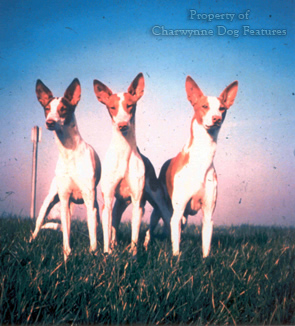 We holiday a great deal in the Mediterranean yet most British sportsmen seem to know little of the hunting dogs of that region. As a result you are unlikely to find the blood of say an Ibizan Hound, a Pharoah Hound, a Portuguese Podengo or a Greek Hound featuring in the lurcher blends of Britain. This is a loss for these breeds are hardy, have superb feet, good noses, remarkable hearing and lightning reactions to quarry and proven prowess on rabbit, a more difficult catch than many realise. These Mediterranean hounds hunt by sight and scent and cannot be pigeon-holed as either scent or sighthounds. This alone should attract the interest of lurcher men looking beyond outcrosses to pastoral breeds, however clever and biddable the latter may be. But as the range of quarry here is now legally limited and rabbit or rat hunting easily-available sport, a look at these all-round sporting dogs makes some sense.
We holiday a great deal in the Mediterranean yet most British sportsmen seem to know little of the hunting dogs of that region. As a result you are unlikely to find the blood of say an Ibizan Hound, a Pharoah Hound, a Portuguese Podengo or a Greek Hound featuring in the lurcher blends of Britain. This is a loss for these breeds are hardy, have superb feet, good noses, remarkable hearing and lightning reactions to quarry and proven prowess on rabbit, a more difficult catch than many realise. These Mediterranean hounds hunt by sight and scent and cannot be pigeon-holed as either scent or sighthounds. This alone should attract the interest of lurcher men looking beyond outcrosses to pastoral breeds, however clever and biddable the latter may be. But as the range of quarry here is now legally limited and rabbit or rat hunting easily-available sport, a look at these all-round sporting dogs makes some sense.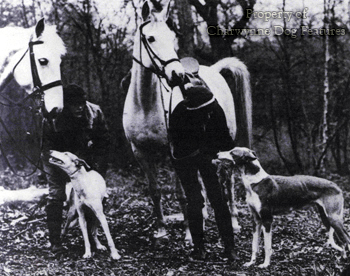
German scientist Max Hilsheimer has linked all these hounds to a common ancestor the Tesem, writing: 'This breed has died out in modern Egypt, but still exists in Crete, the Balearic Islands and Pityusa...The island of Ibiza is the chief breeding centre...' Long-time Ibizan Hound breeder, Rafael Serra of Vinebre near Catalunya in Spain, has written that: 'The Ibizan Hound is a farmer's hunting dog...which hunts rabbits in packs over rough rocky terrain, mainly at a ground-covering trot, but which needs repeated short bursts of speed involving extreme agility and high jumps.' There is, unusually for this type of hound, a rough-coated variant, believed to come from an outcross to hounds from further north. Ibizans will retrieve live game to hand, having soft mouths despite their sharp muzzles. They are distinctive, with their pink noses, large mobile ears, amber eyes and a wrinkled frown. They are renowned for their 'suspended trot', an effortless economical 'hover-stride', of value in a hot dusty energy-sapping terrain.
Not every lurcher expert has written to recommend these Mediterranean breeds however. Brian Plummer, in his Secrets of Dog Training (Robinson, 1992) stated: 'Not only do these hounds possess the rather remote disposition of the typical Middle Eastern sighthound, but they also have excellent olfactory senses and a tendency to run head down on the scent of game...In the hands of an experienced and competent trainer, the pharaoh hound and the Ibizan hound can be versatile and useful hunting dogs - in Malta and the Balearic Islands they occupy the same role as the lurcher in Britain - though they are infinitely more difficult to train...when I specialised in training recalcitrant sighthounds, owners of Ibizan and pharaoh hounds were the most frequent clients.' Not the best recommendation and from an informed source.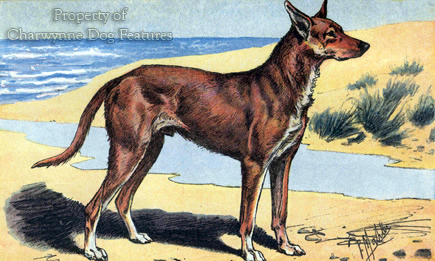
But the blood of the Ibizan Hound brings with it well above average hearing, a priceless attribute in an all-round hunting dog, like the lurcher. Breeders here may not favour the bat-ear but its shape and position acts like a radio-receiver, enhancing sound considerably. We talk of sight and scent hounds, but hunting dogs, terriers especially, rely on their hearing much more than we admit. If you ally this benefit to keen eyesight, discerning scenting powers, astonishing agility for a tall dog and impressively-quick reflexes, you have some very desirable lurcher ingredients. The Ibizan Hound may not be making great progress here as a breed, for although 25 were entered for Crufts in 1980, only 8 were registered with the Kennel Club in 2010, but that doesn’t mean they do not have value by way of introducing fresh blood.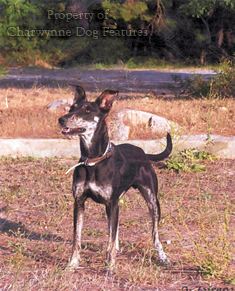
Known throughout the Balearic Isles and across into Valencia and Barcelona, with a Catalan name of Ca Eivissenc, known as the Charnique in the south of France and the Balearen Laufhund in Germany, its hunting sequence has been graphically described as: find and flush, pursue at 40 mph, kill with a neck-break, then retrieve to hand. Not a bad write-up for the lurcher role. They have been utilized here by mounted hunters, retrieving well to saddle. The Spanish hunting strain seems as strong, vigorous, robust and uncomplicated today as it must have been centuries ago and the Balearic devotees have taken their job seriously, culling unwanted specimens and only breeding from the best-performing stock. Lithe and elegant, remarkably deer-like and even-tempered companion dogs, they may fade from view here in time, and that will be a loss to British sportsmen; for me, they offer more than the current fondness for bull blood.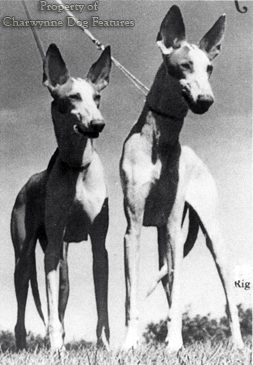
At Crufts in 2010, I was greatly impressed by the Best of Breed winner, Ch Fineza del Paran, a beautifully proportioned hound, and the Best Opposite Sex winner, Necronomicon Ishaq from Finland – where they breed so many really impressive sporting breeds, a distinctive hound, so typical of the hunting type. But show ring fanciers are a fickle lot, so often following a breed whilst it has novelty value only to move on to the next favoured import, out of the allure of the exotic perhaps, but not so good for the breed concerned. Breeders of the purebred Ibizan Hound won’t like my recommending their breed for lurcher breeding, but it’s a tribute to the breed for me, not a sullying.
The physique of this hound is a challenge to sighthound breeders; with upright shoulders, relatively short upper arms and lacking the deep brisket, it seems to defy accepted wisdom for hounds that rely on speed. The Greyhound is expected to have a deep and capacious chest, allegedly to allow ‘heart-room’, even though the heart doesn’t actually require space around it; the Ibizan Hound apparently needs a long flat ribcage, with space between the elbow and the brisket. Its function demands far greater agility than that usually performed by the Greyhound. Half a century ago, when driving to Gibraltar, I stopped at Sitges near Barcelona, where a parade of ‘podencos’ was being held; the hunting demonstration involved a small pack of hounds from Mallorca working a small ravine for rabbit. The hounds worked as a natural team, the smaller ones flushing, the bigger ones chasing, with remarkable success. The terrain was testing and shoulder flexibility essential. It was easy to see why the forequarters were needed the way they were; hounds the world over have to succeed in their country not fit a template. They have to function!